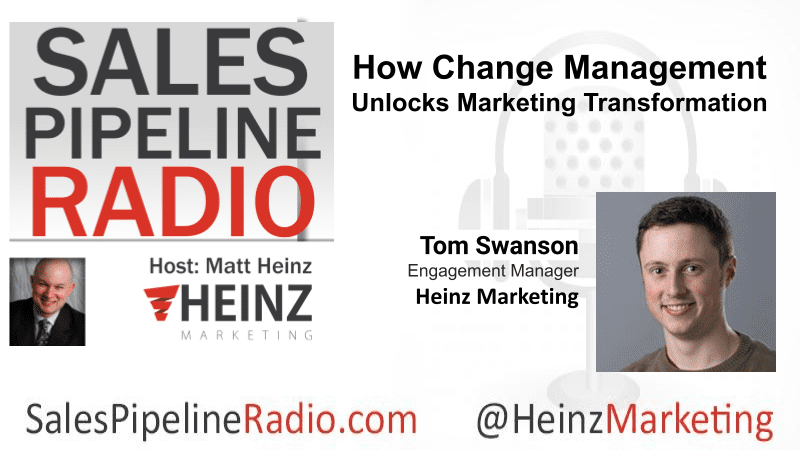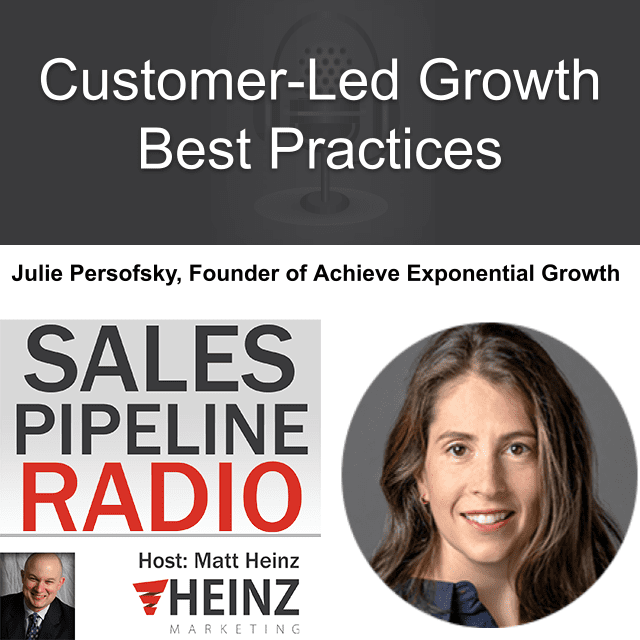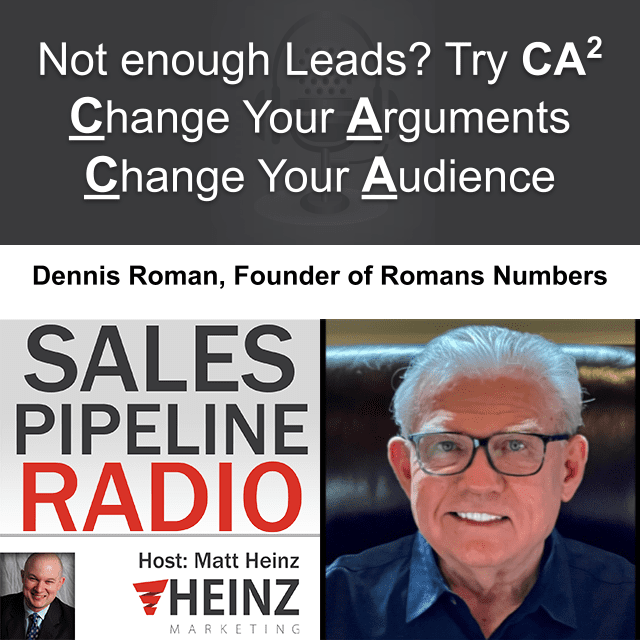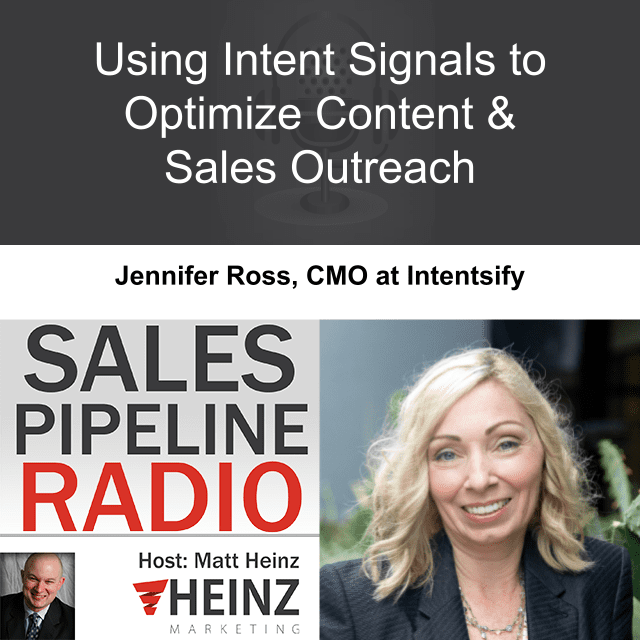Sales Pipeline Radio, Episode 352: Q & A with Tom Swanson

Summary
Matt interviews the best and brightest minds in sales and Marketing on Sales Pipeline Radio.
By Matt Heinz, President of Heinz Marketing
If you’re not already subscribed to Sales Pipeline Radio or listening live Thursdays at 11:30 am PT on LinkedIn (also on demand) you can find the transcription and recording here on the blog every Monday morning. The show is less than 30 minutes, fast-paced and full of actionable advice, best practices and more for B2B sales and marketing professionals.
We cover a wide range of topics, with a focus on sales development and inside sales priorities. You can subscribe right at Sales Pipeline Radio and/or listen to full recordings of past shows everywhere you listen to podcasts! Spotify, iTunes, Blubrry, Google Play, iHeartRADIO, Stitcher and now on Amazon music. You can even ask Siri, Alexa and Google or search on Audible!
This week’s show is entitled, “How Change Management Unlocks Marketing Transformation“ and my guest is our own Tom Swanson, Engagement Manager at Heinz Marketing.
Tune in to:
- Unleash the power of marketing orchestration with strategies to drive predictable outcomes and create a seamless marketing process.
- Discover how change management impacts marketing success and learn how to reduce inefficiencies without burning out your team.
- Gain actionable tips to enhance collaboration, communication, and strategic alignment for maximum marketing impact.
Watch the video, listen in below and/or read the transcript below.
Matt: All right. Welcome everybody to 2024. Happy New Year to everyone watching live. Welcome to another episode of Sales Pipeline Radio. Our first, obviously of 2024, my name is Matt Heinz. I’m your host and excited to kick off a new year. We’ve got a lot of fun plans. For the show this year and excited to get those going.
If you are watching live, if you’re engaging live today on LinkedIn or YouTube very excited to have you here in the middle of your workday, middle of your work week, if you have a comment, a question or a rebuttal. A disagreement, a celebration, anything you want to share with us, please feel free to put those into the comments of the show.
We would love to make you part of today’s show. As we continue to go, we’ll be able to reference those. We’ll be able to see those. We can pull some of those up on screen as well and make you part of the show. So thank you so much for doing that. If you’re accessing, watching, listening on demand, thank you so much for subscribing and downloading every episode of Sales Pipeline Radio past, present, future, always available on salespipelineradio.com. Really excited to kick off this year with one of our own Tom Swanson engagement manager at Heinz Marketing. Tom, thanks for joining us. Happy new year.
Tom: Yeah. Happy new year. Excited to be here.
Matt: Really excited for this topic. I think change management in marketing is kind of a constant, but the nature of go to market in B2B increases in complexity as the buying journey and buying committees increase in complexity as the required integration across marketing teams and between sales and marketing increases, marketing orchestration has become a greater and greater theme in the conversations we’re having. And there’s marketing orchestration and then there’s change management.
And I think they are somewhat related. You and your team have spent quite a bit of time over the last year plus helping organizations work through that change, develop process playbooks to really drive more predictable outcomes from those engagements. Start from the top, marketing orchestration, change management, how are they related and why are they so important?
Tom: Change management’s a really fun topic for me. I have enjoyed that being a major part of my career for the past 10, 15 years now. It’s just been a constant for me. And they tell you in Marketing 101 that marketing changes all the time. And at a rate that’s faster than other facets of business. So it’s funny that marketing struggles so much with change.
You’d think we’d be really, really good at it. But we’re not so, especially when it comes to orchestration, at least for us. There really isn’t anything that change management doesn’t touch from a high level. So the relationship is sort of the same as it is in other elements of business.
But where it really starts to come to a head is when you’ve got multiple teams working together and marketing tends to have this far more than other areas. Maybe product would be similar in the sense that you have strategic teams and planners and tactical execution teams. In some companies, you have an internal agency that does content production.
And so when you’re looking at how do you orchestrate a marketing campaign, let’s just use the easy thing to talk about, which is campaigns. How do you go from an idea or a concept of a campaign all the way through to having the content In market, ads assigned and running, everything tracked and reporting all the way through to the other end and then optimization on the back. Doing all of that stuff is really challenging to begin with but then when you realize there are inefficiencies in the process, because there always are, how do you change something without burning people out? Because the other piece of this too, and we run into this all the time is we come into teams where they’re making five or six different change efforts all at the same time and fatigue with change is a real thing.
I mean, every time you ask somebody to do something differently than they’ve done before, it adds a little chunk of cognitive load onto the top of what they’re already dealing with day to day in addition to the stresses of their regular job. So our big goal is to try and find ways to effectively manage change among other concurrent efforts, reducing where we can so that we can get more efficient while not burning our people out.
Matt: You talk about the human element of this and we have spent 15 years of Heinz marketing, doing strategy process playbooks for companies to drive more predictable results, but a playbook doesn’t play itself, right.
I mean, even though we have an increasing amount of tools and automation and other robots, even before we get into AI to help us do some of this work, it still requires people to implement, right? And I don’t think we’re anywhere close to robots selling to robots. So we’re going to have to continue to manage that people element.
Why do you think that leverage or consideration of that human element is missing? And what are some of the risks of rolling out a playbook without considering the change management, culture management components?
Tom: There’s a few reasons for it. I’ve heard everything from we want people to just be able to figure it out or people should just be able to work together is the one I think I’ve heard the most commonly. It’s just not something that folks consider. When you’re looking at making a change from the top, especially if you’re in a leadership position, it’s really easy to look at and think, yeah, this makes sense. Like, why wouldn’t we do it? Why wouldn’t we make this adjustment? So what we tend to do is sit down and talk to people at the front line on the individual contributor level and hear what they have to say about it.
There’s this old 1989 study. It’s called the Iceberg of Ignorance, which is a really aggressive name for it. But essentially what it, what it stated in 1989 was that leadership is only aware of 4 percent of the issues that are going on at the front line. Now, I think that’s changed. I think that’s probably a higher number now than it was then because there’s more channels. There’s more ways to connect with people. There’s things like Slack where you can see shared conversations that are happening. So there’s more ways to connect with that. But I still think the concept holds true. Leaders don’t see necessarily at the highest level what’s going on for the individual contributors, but it goes both ways.
The individual contributors also don’t know what’s going on at the leadership level, what’s being talked about there. So I think the biggest thing, and I’m going to quote Ray Dalio here, my favorite authors need to have some degree of radical transparency, or I guess radical transparency is the degree to which you need to have that visibility between people.
Cause otherwise it’s really easy to forget what’s happening and what individual contributors are facing. And you might see it just as well. They’re doing their tactical execution job or they’re producing content. There’s a lot that’s going on there that you don’t see. And I think that’s the biggest reason why it gets forgotten because again, a good workflow just makes sense in theory, but when you look at the changes that need to happen to people’s day to day and you consider things like fatigue or lack of clarity that’s typically where you run into the issues.
Matt: And I think some warning signs that we hear a lot when we first talk to companies about change management work is you hear things like institutional knowledge.
You’re thinking about assumptions. You hear things about unwritten rules, right? Or unwritten expectations of what should be done. And you know, even just fundamentally, if your ideal customer profile, your ICP, if it isn’t written down, that may sound like a parochial tactical thing, if it isn’t written down, I guarantee it’s being implemented inconsistently, right?
And I think a lot of smart people like, you know, saying, Hey, we’ve all, we never had to have a process for this. We always just did it organically. I talked to a prospect, just an hour ago where, it’s a series C company and things are breaking, right? Lead conversions are plummeting. It’s not because the leads are worse.
It’s because what used to be what could work at a smaller company organically does not scale when you have multiple people across different places, doing different things. What do you see as some of the warning signs for people listening to this and saying like, boy, those are some of the things that I face.
What are some of the pain points and warning signs that you think tells a company that they’re at a stage of growth where they need to invest in change management and marketing orchestration.
Tom: I’d say for me, the biggest one is if you can’t clearly explain your governance model. That’s probably the biggest. If you don’t know who owns what decision and where the information to inform that decision comes from.
We’ve done this for clients in the past where we’ve laid out, Hey, this is how governance of this process works. If that governance model doesn’t exist. It’s probably because decisions were able to be made by a small enough coalition of people, and they were able to get the information that they needed.
Now, as you scale up, that falls apart. I used to work at a company that had a flat structure, which was very interesting, but, I was the first hire there. And I remember I sat down, I talked to some, some of my business contacts to ask them a little bit more about like, okay, how do we run in a flat structure?
And one of them told me it will break at 30 people flat. It did. That’s exactly what happened because it became very difficult to run governance decisions around what needed to be changed, weren’t communicated properly. And we had to kind of build that as we went. And eventually you need some form of governance.
And the biggest thing with that is who is making decisions about the changes to the process? Who owns that? Who assesses the risk of those changes? Who’s talking to the individual contributors and how is feedback getting from them all the way up to leadership. Usually that goes through like an operations team– is what we’ve seen in the past. So that’s one red flag. Another one has been if you feel like you’re getting a lot of resistance to change when you make it, people are pushing back. That’s often misinterpreted. It’s looked at as I’ve heard, like, Oh, people are difficult. They like to throw bombs.
But in reality, what resistance usually is, is the lack of clarity. And I’m gonna again, I love quoting books. So this one’s straight out of the book Switch by, by Chip and Dan Heath. But they pointed out, and I think correctly, so that resistance is often a lack of clarity and people will push back when they don’t understand the piece that they own within it.
So this comes back up to governance, but I think that’s really important to note. So I look for that I look for if they have internal teams, if the internal teams are telling me the marketing teams are telling me, Hey, our internal communications within the team itself works really well, but we struggle to work with these other teams.
That’s an issue for change management and for governance in general. Cross functional communication is really hard. You see it on all kinds of job descriptions. Hey, we want somebody who’s got experience with this. And the biggest red flag for that is when teams don’t feel like they’re working well with each other, but do feel like they’re working well internally.
That’s usually some kind of red flag there. I like to break out [00:10:00] change difficulty across six dimensions. There’s three personal ones and three organizational ones. It’s a communication style, personality and interests for the individuals involved.
And then it’s change requirements, capacity and tolerance for change at the organizational level. So there’s a lot of change efforts going on. Currently tolerance is going to be low. If you don’t have the capacity to deal with it and to talk about it at length, it’s gonna make it more difficult.
Those are kind of the main the main six that I find usually makes changes really difficult or means that somebody is going to struggle in a particular way if there’s dispersion or misalignment on any of those.
Matt: Talking today on Sales Pipeline Radio with Tom Swanson, one of our own, he’s an engagement manager on our team, runs one of our client service teams and has done a ton of work over the the last year plus helping companies with change management developing a better, more predictable marketing orchestration.
You started that by saying one of the most important markers is whether you have a defined governance model. I can hear people. Saying what is a governance model? Do we have one? You kind of walked into that a little bit, but I think that that could be a sign in and of itself. If you don’t know what that is, or if you’re not sure, haven’t heard anyone internal talk about that…
if you are an early stage company person talking about these things, hearing people talk about governance can sound draconian, but if you’re at a big company and you have seen the impact you can have on efficiency, on predictability, on employee satisfaction and loyalty and retention.
And the chaos that exists if you don’t have this in place, right? Huge difference. You talked about something that I think is light for companies that will push back on this, which is this tolerance for change. A lot of companies just want to wish that it’ll all be fine, right?
And not have to invest, instead of investing money on and time on campaigns, we have to invest it on process. And that sounds counterproductive to people. And that may not be part of why they have a low tolerance for change, but talk about that trade off and how you help companies think through that.
Tom: We’ve got a way that we approach this to try and make the case, right. It’s a bow tie as with a lot of things in marketing is the format, but it’s like a bow tie of seniority where I like to start at one end talking to leaders. Hearing what they think, where are their issues? And then I go to the individual contributors and I hear from them and say, okay, cool.
It’s what we’re hearing from the leadership. Does this match up? If not, what’s the issue where are the problems, where is it misaligned? Then I draw it all up. Or at least my team and I do, and we sit there, we make an actual working model for how things are now and where the disconnects are between the individual contributors and the leaders.
We bring it back to the individual contributors. Say, Hey, does this match up with what you’re hearing? What you’re seeing? What did we miss? What did we get wrong? And then we go back to the leaders and we say, okay, cool, we’ve run this through this process. Here is the current model and where the issues are and where those disconnects are.
And I found that that’s really helpful for approaching that problem and and getting leadership buy in on it. Folks have to see it. They have to be able to look at the model and say, yes, these are where the issues are. And then the leaders knowing that that’s been vetted by the people on their teams, I think it’s really eye opening at that point.
The other piece of it is. It’s quality of life. If you want to retain the best talent, there’s no better way to do it in my opinion, than to be really intentional about how you deal with change. Frequent, even constant changes as are necessary in marketing can really kill somebody’s quality of life if they’re having to constantly adjust how they’re doing things in ways that they might not have control over or haven’t bought in on.
I have found, at least in my experience, that that’s a big reason that people leave companies is they made all these changes. They didn’t feel like they were consulted. They didn’t get the chance to weigh in. And as we found out time and time again, if there’s no weigh, then there won’t be any buy in, which is kind of our catchy way of saying it. But that’s been a big one as well. And so you look at what’s the cost of hiring a person? And if we want to just bring it down to profit, it’s a high cost to hire.
Hiring is the most important thing a company does. I would love to say that it’s marketing or handling change or any of the things that I do, but it isn’t. It’s hiring. Who you bring into the company matters more than anything else and so you put a lot of time and energy and effort into doing it right.
And that’s really costly. So when you do it right, don’t lose those people because they’re tired of changing and they want to go to somewhere where they have a bit more of a feeling of stability.
Matt: Wrapping up our last few minutes here with Tom Swanson on a change management, marketing orchestration.
You have developed a scorecard for marketing and change management. And I thought it was really smart. Cause I think a lot of companies like you sit in and you’re saying you stare at your same four walls. And you don’t know what you don’t know. And it’s really hard to benchmark yourself against where other companies are.
Here’s what we do. Is this good? Is this great? Is this awful? Anyone who’s watching this and wants a copy, email Tom or I, or just send a note into the company on our homepage and our website, we’ll get a copy for you, but talk a little bit about the marketing orchestration scorecard and what are the components?
Cause I think there’s four or five focus areas there that you typically try to benchmark and score.
Tom: It kind of follows a one through five star, obviously one being low we call it initial ad hoc defined, manage and optimize that’s, typical Heinz Marketing language, but the dimensions that we’ve put it across are collaboration communication. This is what I was talking about earlier. Do teams communicate with each other and if there’s internal processes and communication that are good, but, inter team or cross functional communication, that’s where things are failing, that might be in the ad hoc or defined.
But what we really are looking for is how well our teams able to work with each other. And is there a smooth flow of information from one team to the other? So we’re looking for that.
Roles and processes. We like to use a RACI on occasion. I’ve been known to use a DACI, which is a little bit different. I wrote a blog post about the difference between the two and when to use them. It bothers me that those acronyms are so similar when the actual concept is quite different. But we typically use a RACI to outline and get clarity on roles and responsibilities. So that’s what that one is.
Project management tools. This is a bit more of the tech side of it. Are people using the pm tools that you have and can you easily tell where a project is at? They’re all interlinked, but I like to see communication happen in the project management tool itself.
Like for example, if you’re using Monday or Workfront, are comments, discussions, even if there’s an offline collaboration, is that tracked within the project management tool such that the project manager can look at it and know what was discussed and what the outcomes were. Because what we find happens time and time again is that the PMs don’t know what’s going on because two of the people working on the actual content itself got together and made a bunch of decisions without telling anybody. So that happens pretty commonly. That’s what we look at.
And then last but not least is strategic alignment and planning. That’s our last one. This one gets interesting because a lot of the issues that we see happen at the gap between the planning teams and the production teams or the execution teams.
That’s been a really big one to jump, but how aligned is the team around the strategy? So we all know strategy is a framework for making decisions. So do the teams feel like they can make decisions that are aligned with the strategy? And do leadership agree that the decisions that the teams are making are aligned with the strategy?
So that’s what we look at to make sure that everything is orchestrated properly because you can’t have leaders in their micromanaging every decision. You have to delegate that to your people, but they can’t do that effectively if they don’t have a clear strategy to begin with.
Matt: Love it. Well, if you want to copy that scorecard, let us know Tom referenced some marketing orchestration content that he and his team have been putting up.
Just go to Heinz marketing, click on blog, and you can sort by change management. You can sort by marketing orchestration. So thank you, Tom, for sharing your genius and your expertise. Appreciate it very much.
Tom: Yeah, of course. Anytime. Feel free to reach out to me too. It’s just tom@heinzmarketing.com. Happy to chat.
Absolutely. Awesome. Well, thanks everyone for listening and watching. We’ll see you next week for another episode until then my name is Matt Heinz. We’ll see you next week on Sales Pipeline Radio. Take care.
Listen to the Latest Episodes:
Matt interviews the best and brightest minds in sales and Marketing. If you would like to be a guest on Sales Pipeline Radio send an email to Sheena@heinzmarketing.com.



